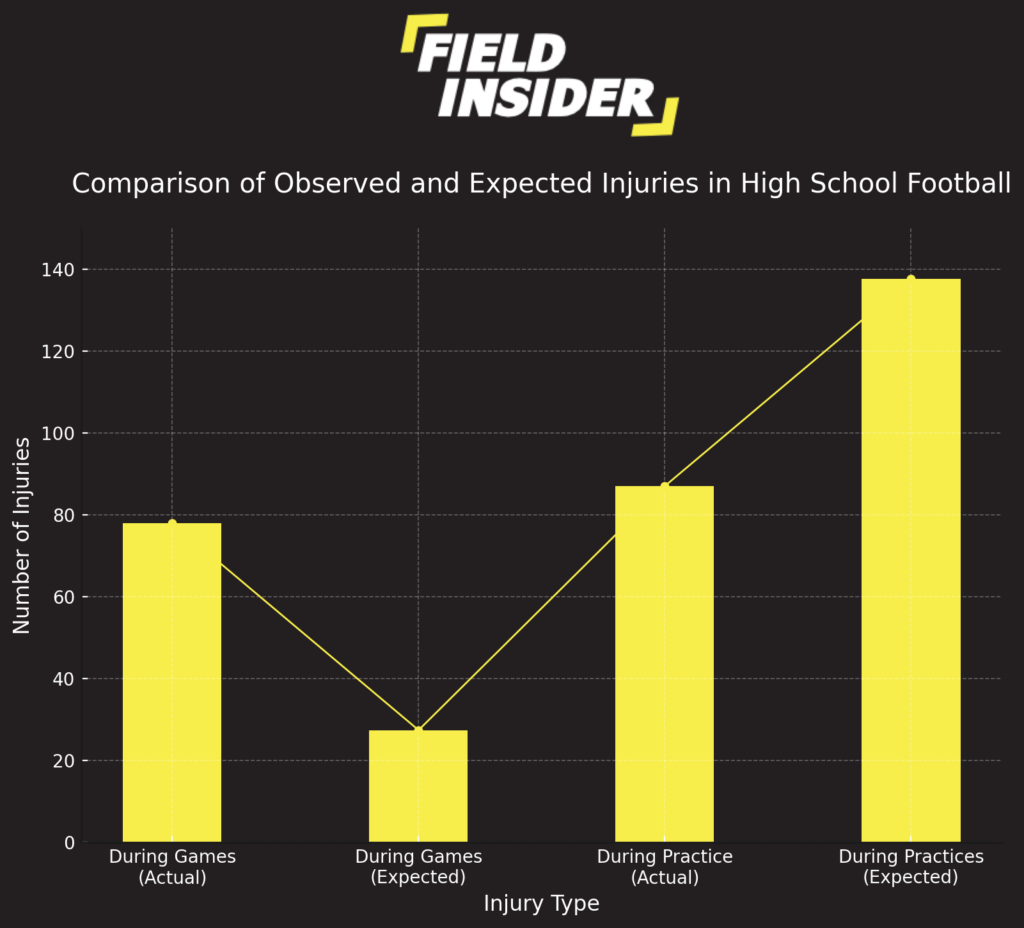Complete Guide On High School Football (Soccer)
High school football, often the cornerstone of a young athlete’s development, offers more than just the thrill of competition; it provides a unique blend of personal growth, teamwork, and discipline. It’s where skills are honed, character is built, and lifelong friendships are forged.
This guide is designed to walk you through every aspect of high school football, from understanding the basics to navigating the complexities of team dynamics and college opportunities.
Key Takeaways
| Key Takeaways | Details |
|---|---|
| Understanding the Basics | Learn rules, positions, and the importance of strategy with insights from football rules. |
| Getting Started | Prepare for tryouts, establish practice routines, and understand the coach’s role. |
| Season Navigation | Focus on regular season matches, prepare for tournaments, and balance academics with high school football. |
| Skill Development | Enhance physical fitness, technical skills, and mental focus with exercises from football training. |
| Team Dynamics | Build communication, trust, and learn to handle outcomes collectively, underlining teamwork. |
| Scholarships and College Opportunities | Understand the significance in admissions and navigate recruitment, emphasizing the role of high school football. |
| Overcoming Challenges | Address injuries, performance slumps, and pressure with strategies from preventing injuries. |
| Beyond High School | Prepare for the transition beyond high school, maintaining passion and determination. |
Understanding High School Football

Football Rules and Gameplay
In high school football, knowing the rules is fundamental. Football rules dictate the structure and flow of the game, ensuring fairness and sportsmanship. It’s crucial for players to understand offside rules, fouling penalties, and the game’s objectives.
Familiarity with these rules not only improves gameplay but also enhances the player’s ability to make quick, strategic decisions on the field.
Different Positions and Their Roles
Every position on the football field has a unique role and set of responsibilities. From the strategic placement of a goalkeeper to the dynamic roles of midfielders and forwards, understanding each position is vital.
For a deeper dive, the 5-a-side positions guide provides insights into smaller team formats, which can be foundational for understanding larger 11-a-side dynamics. This knowledge helps players adapt to various positions and understand their teammates’ roles, fostering a cohesive team environment.
Importance of Strategy and Tactics
Strategy forms the backbone of football, influencing both individual and team success. Players and coaches must work together to develop effective strategies, often adapting to the strengths and weaknesses of their opponents.
Familiarizing oneself with various football formations, such as the balanced 4-4-2 or the aggressive 3-4-3, can significantly impact a team’s performance. A well-thought-out strategy enhances team coordination, allowing players to exploit opportunities and mitigate threats during play.
Getting Started
Tryouts and Team Selection
Tryouts are the first step in your high school football journey. They are an opportunity to showcase your skills, attitude, and work ethic. Preparation is key: focus on physical fitness, technical skills, and understanding the game’s fundamentals.
Stand out by demonstrating not just your talent, but also your ability to listen and adapt. For more guidance, consider advice on becoming a vital team player from resources like help in a youth soccer team.
Practice Routines and Drills
Consistent practice is the cornerstone of improvement in football. Establishing a routine that includes a variety of drills can significantly enhance your technical skills and physical fitness.
Incorporate football training exercises at home to continue improving even outside of team practices. This not only shows dedication but also allows you to refine your skills, making you a more competitive player during tryouts and the season.
Understanding the Coach’s Role
The coach plays a crucial role in your development as a player. They provide guidance, strategy, and feedback to help you grow. Understanding and respecting the coach’s role is essential for your improvement and team dynamics.

Engage with your coach, ask for feedback, and demonstrate your willingness to learn and adapt. This relationship is pivotal for your football journey, as highlighted in resources about coaching roles in youth football.
Regular Season Matches
The regular season is where you’ll spend most of your time showcasing and honing your skills in real competitive environments. Each match is an opportunity to apply what you’ve learned in practice and to stand out in your team.
It’s essential to stay focused, maintain peak physical condition, and consistently apply your coach’s strategies. Regular season performance is crucial, not just for your team’s success, but for personal growth and potential scouting opportunities.
Tournaments and Championships
Tournaments and championships represent the pinnacle of high school football competition. They provide a stage to display your abilities against the best players and teams. Preparation for these events involves physical conditioning, mental preparation, and tactical planning.
Embrace the heightened intensity, while maintaining composure and adherence to your team’s game plan. Success in tournaments can significantly impact your football journey, offering exposure and memorable experiences.
Balancing Academics and Athletics
Balancing academics with athletics is a critical challenge for high school football players. Success on the field is important, but maintaining academic performance is equally crucial. Develop a schedule that allocates time effectively between studies and football, ensuring neither is neglected.

Remember, academic achievements can be as important as athletic performance, especially when considering college opportunities and scholarships.
Nurturing Talent: Prominent High School Soccer Programs in the USA
In the United States, high school soccer programs and organizations play a crucial role in the development of young athletes. Here are some examples:
| Organization/Program | Focus/Area |
|---|---|
| National Federation of State High School Associations (NFHS) | Rule-making and guidelines for high school sports |
| United Soccer Coaches High School Program | Resources and training for high school coaches |
| US Youth Soccer | Youth development and support for high school players |
| High School Soccer Teams and Leagues | Statewide competitions and leagues |
| Scholastic Cup and State Championships | Annual tournaments leading to state championships |
| Olympic Development Program (ODP) | Identification and development of young soccer talent |
Understanding the High School Soccer System
High School Soccer Leagues
In the U.S., high school soccer leagues are typically organized by state-level interscholastic athletic associations. These leagues are divided based on various factors, including geographical location, school size, and competitive level.
The main objective is to provide a structured and equitable competitive environment. States like California, Texas, and New York, for example, have their own respective organizations which oversee the competitions, establish rules, and ensure fair play.
Seasonal Schedules
High school soccer seasons vary by state and region, primarily influenced by climate and overlapping with other sports. Typically, there are fall and spring seasons. The fall season usually starts in August and ends in November, while the spring season often begins in February and concludes in May.
Each season includes regular league matches, followed by post-season tournaments leading to state championships.
Post-Season Tournaments and Championships
After the regular season, teams compete in post-season tournaments, which often determine regional and state champions. The format and qualification criteria for these tournaments can vary significantly from one state to another.
Generally it includes single-elimination games where teams must win to advance. These high-stakes matches add intensity and excitement to the high school soccer experience, providing players with the opportunity to showcase their skills on larger stages.
Developing Skills and Improving Performance
Physical Conditioning and Fitness
Physical fitness is a cornerstone of success in high school football. A well-conditioned athlete can perform at their best for longer, resist injuries, and recover more quickly. Focus on a balanced fitness regimen that enhances your strength, endurance, speed, and agility.
Regular physical conditioning, including cardio exercises, strength training, and flexibility workouts, can significantly impact your performance on the field. Explore targeted routines and tips from resources like physical training in football to elevate your physical condition beyond the basic requirements.
Technical Skills Training
Technical skills are what set players apart on the field. Mastery of ball control, passing, shooting, and tactical understanding can make a significant difference in match situations. Dedicate time to practice fundamental skills as well as position-specific techniques.
Regularly engaging in individual football training can help refine your abilities and boost your confidence during play. Remember, consistent practice leads to improvement, so incorporate technical drills into your daily routine.
Mental Preparation and Focus
The mental aspect of football is just as important as the physical and technical ones. Mental preparation involves setting goals, maintaining a positive attitude, and developing resilience against setbacks.
Focus on building mental toughness to handle pressure situations, such as penalty kicks or crucial matches. Techniques like visualization, meditation, and goal-setting can enhance your mental readiness and focus.
Understand the psychological demands of the game and use resources to bolster your mental preparation.
Analyzing Injury Trends in High School Football
The study, “The Effect of Life Events on Incidence of Injury in High School Football Players” has revealed intriguing trends in high school football injuries. The chart visualizes actual versus expected injuries, adjusted for athlete exposures.

In an unexpected turn, the actual injuries during games significantly exceed the expected count. This alarming trend suggests that the competitive, high-stakes nature of game environments might contribute to a higher risk of injuries.
Factors such as aggressive play, high-speed collisions, and the pressure of performance could escalate the likelihood of incidents beyond anticipated levels.
On the flip side, practice sessions present a contrasting scenario, with actual injuries falling below expected figures.
This could be attributed to the controlled nature of practice environments, where coaches can regulate contact levels, focus on technique, and implement preventative training measures.
Additionally, the lower intensity compared to game situations might reduce the overall injury risk during practices.
These findings highlight the necessity for targeted interventions aimed at reducing game-related injuries. Enhancing protective gear, refining game-day protocols, and fostering a culture that prioritizes player safety could bridge the gap between expected and actual injury rates.
Building Team Dynamics and Camaraderie
Importance of Communication and Collaboration
Effective communication is pivotal in building a successful football team. It involves more than just talking; it’s about expressing ideas, intentions, and feelings clearly and constructively, whether on or off the field.
Good communication helps in aligning team strategies, resolving conflicts, and fostering a positive team environment. Players should strive to be open, supportive, and understanding towards each other, enhancing overall team performance.
Developing Trust and Unity
Trust and unity within a team can significantly affect its cohesion and performance. Developing trust involves demonstrating reliability, integrity, and fairness in all interactions with teammates.
Unity is built through shared goals, mutual respect, and collective responsibility for the team’s successes and failures. The stronger the trust and unity, the more resilient and effective the team becomes in facing challenges together.
Handling Wins and Losses as a Team
Handling wins and losses with grace is essential to maintaining team morale and dynamics. Celebrate victories modestly, recognizing the effort of all team members and learning from the experience.
In the face of losses, adopt a constructive approach by analyzing what went wrong, learning from mistakes, and moving forward positively.
Embrace both outcomes as part of the learning process, and maintain a supportive environment where teammates encourage each other regardless of the result. Understanding how to handle wins and losses as a team is crucial for long-term development and success in high school football.
Scholarships and College Opportunities
Importance of High School Football (Soccer) in College Admissions
High school football can play a significant role in college admissions, especially for student-athletes seeking scholarships. Excelling in soccer can highlight a student’s teamwork, leadership, and discipline, traits highly valued by college admissions officers.
It’s important to maintain a strong academic record alongside your athletic achievements, as this balance is often a key factor in scholarship considerations.
The recruitment process for college soccer can be complex and competitive. Start early by identifying colleges that fit your academic and athletic aspirations. Create a highlight reel and an athletic resume to showcase your skills and achievements.
Attend college soccer camps and recruitment events to gain exposure and communicate directly with college coaches. Understanding the recruitment timeline and requirements is crucial, so utilize guides and resources designed to navigate the college soccer recruitment process effectively.
Balancing Athletic and Academic Goals
Balancing athletic aspirations with academic responsibilities is crucial for high school football players aiming for college opportunities. Prioritize time management to ensure both your schoolwork and soccer training receive adequate attention.
Develop a support system among coaches, teachers, and family to help maintain this balance. Remember, academic performance can significantly impact scholarship opportunities, so it’s important to excel both on the field and in the classroom.
Dealing with Challenges and Setbacks

Injuries and Rehabilitation
Injuries are an unfortunate part of sports, including high school football. Proper prevention strategies, such as warm-up routines, strength training, and using correct techniques, can reduce the risk. However, if injuries occur, it’s crucial to seek professional medical advice and adhere to a rehabilitation plan.
Understanding the importance of rest, recovery, and gradual return to play is vital. Resources like prevent injuries for your kids offer guidance on how to minimize injury risks and deal with them effectively when they happen.
Overcoming Performance Slumps
Performance slumps can affect even the most talented athletes. Identifying the underlying causes, whether they are physical, technical, or psychological, is the first step to overcoming them. Maintain a positive mindset, focus on the basics, and seek feedback from coaches and teammates.
Remember, slumps are temporary, and persistence, along with the right approach, will lead to improvement. Utilize strategies from articles on overcoming difficulties, such as focusing on individual football training to regain confidence and form.
Handling Pressure and Expectations
High school football players often face significant pressure and high expectations from themselves, their peers, and their coaches. Learning to manage this pressure is essential for personal and athletic development.
Techniques such as goal-setting, mindfulness, and focusing on the process rather than the outcome can be beneficial. Remember, it’s essential to enjoy the game and the experience, using pressure as a motivator rather than a hindrance.
Conclusion
In conclusion, high school football is more than just a sport; it’s a comprehensive experience that shapes young athletes in numerous ways, from enhancing physical fitness and technical skills to developing mental resilience and teamwork.
As you navigate through this journey, remember the importance of dedication, continuous learning, and balance between your academic and athletic pursuits. Embrace every moment on the field, learn from your experiences, and carry these lessons forward, as they will serve you well beyond the realm of high school football.








